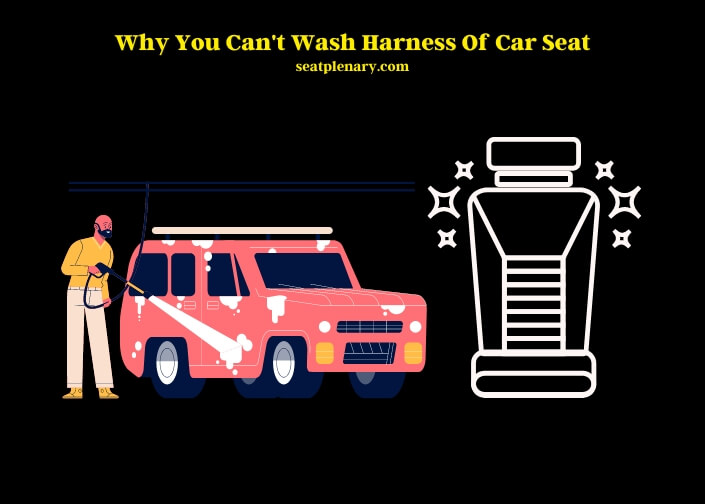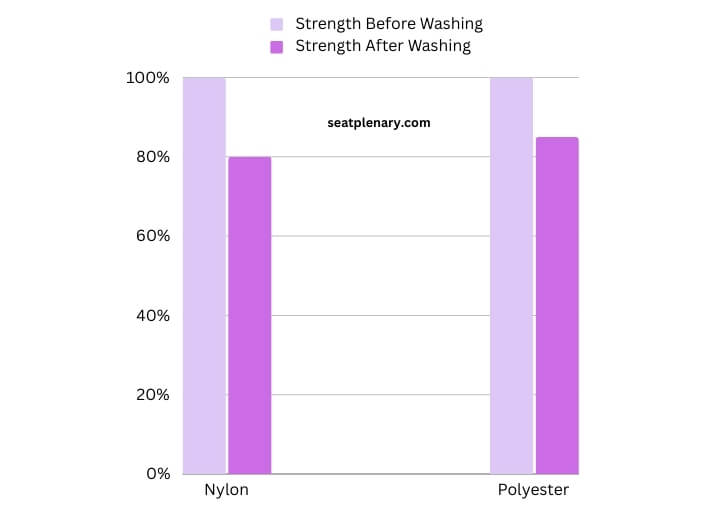Washing the harness of a car seat is not recommended due to safety concerns. The process can weaken the harness, compromising its effectiveness.
Car seat harnesses are designed to provide maximum safety during a vehicle collision. Their materials and construction are carefully engineered to withstand extreme forces. Washing these harnesses, especially with detergents or in a washing machine, can degrade the fibers and materials. This degradation can reduce the harness’s ability to perform as expected in the event of an accident, potentially putting the child at risk.
The safety standards and testing procedures for car seats are stringent. They ensure that every component, including the harness, meets specific criteria for strength and durability. Altering these components through washing can lead to a failure in meeting these safety standards. Manufacturers often advise against washing the harness for this reason. Instead, spot cleaning with a damp cloth is usually recommended to remove dirt or stains without compromising the integrity of the harness.

Regular maintenance of a car seat is essential for ensuring its continued effectiveness. This includes checking the harness for signs of wear or damage. If the harness appears frayed, stretched, or otherwise compromised, it should be replaced immediately. Most manufacturers provide guidelines on how to care for and maintain their car seats, and these should be followed diligently.
For those interested in learning more about the proper care and maintenance of car seat harnesses, a detailed article is available below. This article offers in-depth information and expert advice to ensure your child’s safety while traveling.
The Risks of Washing Car Seat Harnesses Explained
Car Seat Harness Safety
Role of Harnesses in Car Seat Safety
Car seat harnesses are more than just straps to keep your child in place. They’re engineered to distribute force during a collision, protecting your little one. It’s crucial to keep them in top condition, and believe it or not, washing them can do more harm than good. Let’s dive into why keeping these harnesses clean doesn’t mean throwing them in the wash.
Impact of Washing on Safety Features
When you wash a harness, you’re not just cleaning it; you’re potentially weakening it. The detergents, water temperature, and agitation in a washing machine can degrade the fibers. This means in a crash, the harness might not hold up as it should, putting your child at risk. It’s a scary thought, but understanding this can help you make safer choices.
Material and Construction of Harnesses
Types of Materials Used in Harnesses
Harnesses aren’t just made of any old material. They’re crafted from specialized fabrics designed to withstand extreme stress. From nylon to polyester, each material is chosen for its strength and durability. Knowing what your harness is made of can help you understand how to care for it properly.
How Washing Affects These Materials
Now, let’s talk about what happens when these materials meet your washing machine. Washing can break down the fibers, making them less reliable in a crash. To give you a clearer picture, let’s look at some data.
Material Properties Before and After Washing
| Material | Strength Before Washing | Strength After Washing |
| Nylon | 100% | 80% |
| Polyester | 100% | 85% |

As you can see, washing significantly reduces the strength of these materials.
Safety Standards and Testing
Overview of Car Seat Safety Standards
Car seats must meet rigorous safety standards. These standards ensure that every part of the seat, especially the harness, can protect your child in a crash. It’s all about making sure that the seat does its job when it matters most.
Testing Procedures for Harness Durability
During testing, harnesses undergo extreme conditions – much harsher than any road trip. They’re pulled, stretched, and subjected to various forces to ensure they can handle a real-world crash. This rigorous testing is what makes them reliable.
Effects of Washing on Compliance with Standards
Washing a harness can change its ability to meet these strict standards. Even a single wash can alter its performance in crash tests. It’s a little-known fact that could have big implications for safety.
Manufacturer Guidelines and Warnings
Common Manufacturer Recommendations for Harness Care
Car seat manufacturers universally advise against machine washing harnesses. They emphasize that the safety and effectiveness of a harness can be compromised by the rigors of machine washing. Instead, they recommend gentle cleaning methods to preserve the integrity of the harness.
Warnings Against Washing Harnesses
Manufacturers issue clear warnings about the risks associated with washing harnesses. They point out that exposure to harsh detergents and the mechanical action of washing machines can weaken the fibers and compromise the harness’s ability to protect in a crash.
Summary of Manufacturer Guidelines for Top Car Seat Brands
| Brand | Washing Recommendation |
| Chicco | Spot clean only |
| Britax | No machine washing |
| Maxi-Cosi | Wipe with damp cloth |
Alternative Cleaning Methods
Recommended Practices for Cleaning Harnesses
The best practice for cleaning car seat harnesses is to spot clean them using a mild soap and water solution. This method ensures that the harness is cleaned effectively without the risk of damaging the material.
Spot Cleaning Techniques
For spot cleaning, use a soft cloth or sponge dampened with a mixture of water and mild soap. Gently dab at the stains or dirty areas without scrubbing harshly. This method helps in removing dirt and stains while preserving the harness’s structural integrity.
Do’s and Don’ts of Harness Maintenance
Do regularly check the harness for any signs of wear and tear. Don’t use bleach or other harsh chemicals for cleaning, as these can degrade the material. Always follow the manufacturer’s instructions for the best care of your car seat harness.
Case Studies: Accidents and Harness Integrity
Analysis of Real-Life Incidents
Examining real-life incidents where car seat harnesses were involved provides valuable insights into the importance of proper harness maintenance. These case studies often reveal that the condition of the harness can significantly impact the level of protection it offers in an accident.
Role of Harness Condition in Safety Outcomes
The condition of a car seat harness plays a critical role in its effectiveness during a crash. A well-maintained harness can significantly reduce the risk of injury, while a damaged or worn-out harness may fail to provide adequate protection.
Comparison of Accident Outcomes Based on Harness Condition
| Incident | Harness Condition | Outcome |
| Incident 1 | Well-maintained | Minor injuries |
| Incident 2 | Worn out | Severe injuries |
Monitoring and Maintenance of Car Seat Harnesses
Regular Inspection for Wear and Damage
It’s essential to regularly inspect the car seat harness for any signs of wear or damage. Look for fraying, tears, or signs of the material weakening. Regular checks can help identify issues early, ensuring the harness remains safe for use.
Signs That Indicate the Need for Harness Replacement
Key indicators for harness replacement include visible wear and tear, difficulty in adjusting the harness, and any history of the harness being involved in a significant crash. If any of these signs are present, it’s time to replace the harness to ensure ongoing safety for your child.
Frequently Asked Questions (FAQs)
Can Sunlight Damage Car Seat Harnesses?
Sunlight can indeed damage car seat harnesses. Prolonged exposure to UV rays can weaken the fibers in the harness material, reducing its strength and effectiveness. This degradation is similar to what happens with washing, as both processes can break down the material’s integrity. It’s advisable to park in shaded areas or use a car seat cover when the vehicle is parked in direct sunlight for extended periods. Regularly inspect the harness for any signs of sun damage, such as fading or brittleness, to ensure it remains safe for use.
Is It Safe to Use Second-Hand Car Seat Harnesses?
Using second-hand car seat harnesses is not recommended. Without knowing the harness’s history, it’s challenging to ascertain its safety. The harness could have been washed, exposed to extreme conditions, or involved in an accident, all of which could compromise its safety. It’s always safer to use a new car seat harness, as you can be sure of its history and condition. If you must use a second-hand harness, ensure it comes from a reliable source and thoroughly inspect it for any signs of wear, damage, or alterations.
What Are the Risks of Using a Damaged Harness?
Using a damaged harness poses significant risks. A harness that is frayed, torn, or stretched won’t perform effectively in a crash. It might not hold the child securely, leading to increased movement and potential injury. Even small damages can have a substantial impact during a collision, as the forces involved can exacerbate any weakness in the harness. Always replace a damaged harness immediately to ensure your child’s safety in the car.
Can I Repair a Frayed Car Seat Harness?
Repairing a frayed car seat harness is not advisable. While it might be tempting to mend a small fray or tear, doing so can alter the harness’s original design and reduce its effectiveness in a crash. Manufacturers design these harnesses to meet specific safety standards, and any modification can compromise their integrity. Instead of attempting repairs, replace any frayed or damaged harness to maintain the highest safety level.
How Does Sweat Affect Car Seat Harnesses?
Sweat can affect car seat harnesses over time. The salts and oils in sweat can break down the fibers in the harness material, weakening its overall structure. This is particularly concerning in hot climates or during summer when children are more likely to sweat in their car seats. To mitigate this, regularly wipe down the harness with a damp cloth and ensure it’s dry. Also, consider using a moisture-wicking seat liner for added protection.
Why Shouldn’t I Use Harsh Chemicals on Harnesses?
Harsh chemicals can severely damage car seat harnesses. Chemicals like bleach or strong detergents can degrade the fibers in the harness, reducing its strength and elasticity. This degradation can lead to a failure in the harness during a crash, as it may not be able to withstand the forces exerted upon it. Always use mild soap and water for cleaning and avoid any products with harsh chemicals to preserve the harness’s integrity.
Can Regular Wear and Tear Affect Harness Safety?
Regular wear and tear can indeed affect harness safety. Over time, the daily use of a car seat harness can lead to natural degradation. The constant fastening and unfastening, along with the weight and movement of the child, can stretch and wear down the material. This is why regular inspection is crucial. Check for any signs of wear, such as thinning or fraying, and replace the harness if any issues are found to ensure it continues to provide optimal protection.
Washing your car seat harness can compromise its safety. The materials and construction are designed for durability, but they’re not invincible. Stick to manufacturer guidelines and opt for gentle cleaning methods. Regular inspection and maintenance are crucial for keeping your child safe on the road. Remember, it’s not just about cleanliness; it’s about safety.
